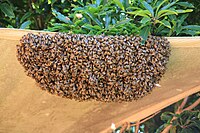
Photo from wikipedia
Simple Summary The western honey bee (Apis mellifera) is commercially kept for crop pollination and production of bee products in China and many other countries. Currently, the circRNA-regulated response of… Click to show full abstract
Simple Summary The western honey bee (Apis mellifera) is commercially kept for crop pollination and production of bee products in China and many other countries. Currently, the circRNA-regulated response of A. mellifera to Vairimorpha ceranae infection is completely unknown. Here, characterization of circRNAs engaged in the response of A. mellifera workers to V. ceranae infection was conducted for the first time, followed by an in-depth investigation of the regulatory role of the hosts’ differentially expressed circRNAs (DEcircRNAs). Our findings not only revealed the underlying molecular mechanism of host response, but also offered novel insights into honey bee–microsporidian interaction. Abstract Vairimorpha ceranae is a widespread fungal parasite of adult honey bees that leads to a serious disease called nosemosis. Circular RNAs (circRNAs) are newly discovered non-coding RNAs (ncRNAs) that regulate biological processes such as immune defense and development. Here, 8199 and 8711 circRNAs were predicted from the midguts of Apis mellifera ligustica workers at 7 d (Am7T) and 10 d (Am10T) after inoculation (dpi) with V. ceranae spores. In combination with transcriptome data from corresponding uninoculated midguts (Am7CK and Am10CK), 4464 circRNAs were found to be shared by these four groups. Additionally, 16 circRNAs were highly conserved among A. m. ligustica, Apis cerana cerana, and Homo sapiens. In the Am7CK vs. Am7T (Am10CK vs. Am10T) comparison group, 168 (306) differentially expressed circRNAs (DEcircRNAs) were identified. RT-qPCR results showed that the expression trend of eight DEcircRNAs was consistent with that in the transcriptome datasets. The source genes of DEcircRNAs in Am7CK vs. Am7T (Am10CK vs. Am10T) were engaged in 27 (35) GO functional terms, including 1 (1) immunity-associated terms. Moreover, the aforementioned source genes were involved in three cellular immune-related pathways. Moreover, 86 (178) DEcircRNAs in workers’ midguts at 7 (10) dpi could interact with 75 (103) miRNAs, further targeting 215 (305) mRNAs. These targets were associated with cellular renewal, cellular structure, carbohydrate and energy metabolism, and cellular and humoral immunity. Findings in the present study unraveled the mechanism underlying circRNA-mediated immune responses of western honey bee workers to V. ceranae invasion, but also provided new insights into host–microsporidian interaction during nosemosis.
Journal Title: Biology
Year Published: 2022
Link to full text (if available)
Share on Social Media: Sign Up to like & get
recommendations!